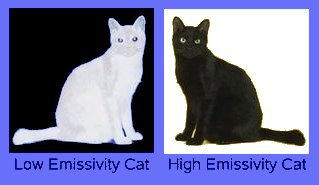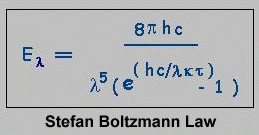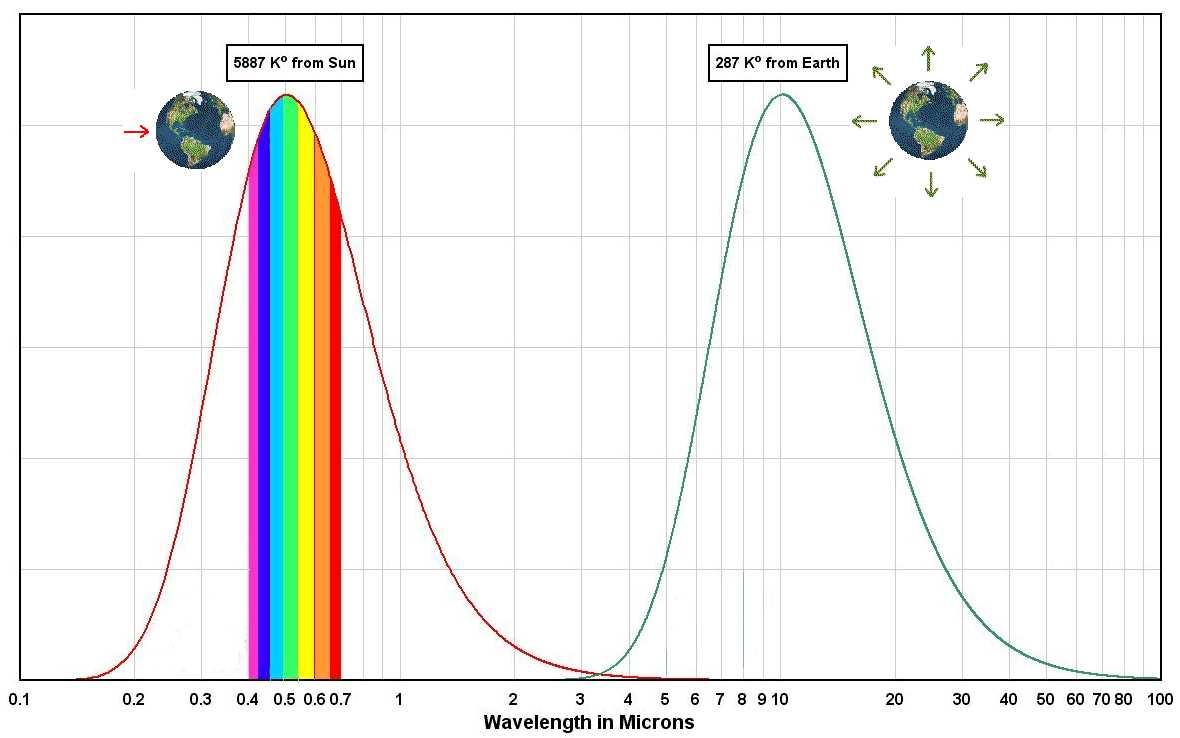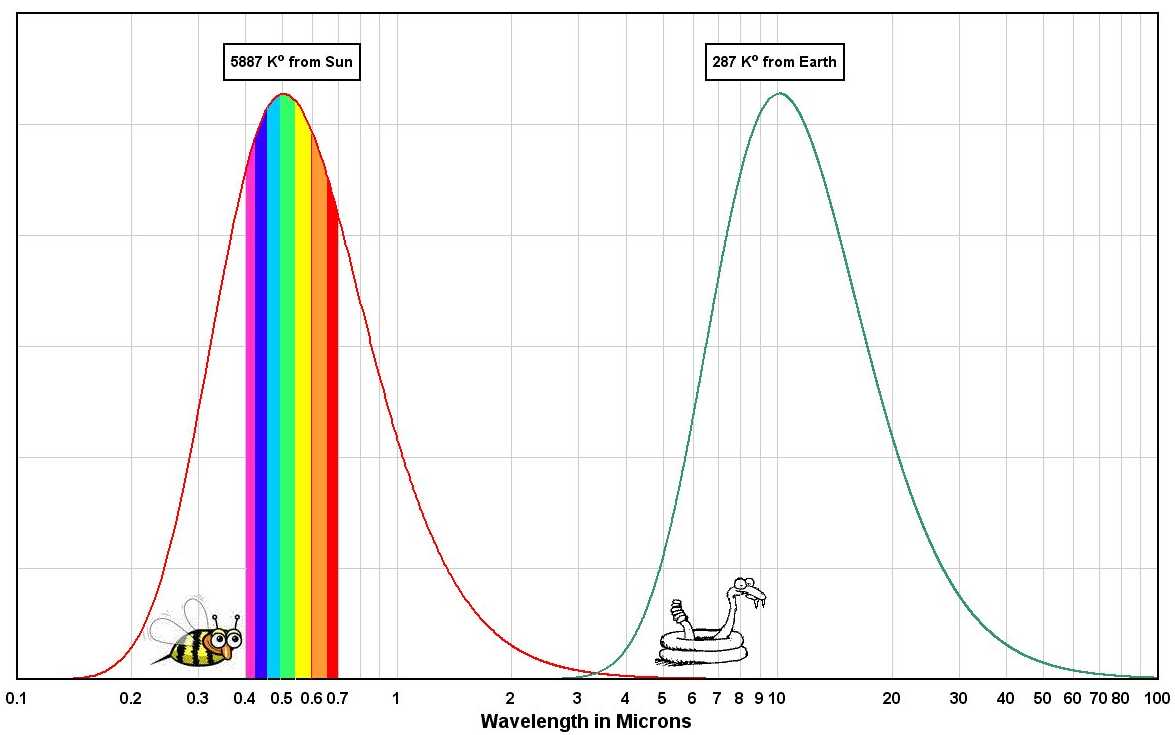An Explanation of the Greenhouse Effect
(Including some Science and Mathematics)
(Including some Science and Mathematics)
Explanations about global warming and the greenhouse effect are common in books and magazines and even in the cinema but usually with the mathematics and science filtered out to make it "intelligible to the layman." They are not wrong or misleading but they are unconvincing. Find out here why the unfiltered explanations are so compelling to scientists.
The metric system is the language of science and metric units will be used here without apology and without the clumsy parenthetic equivalences. The metric system is universal but there is one notable exception--the United States.
The short explanation of the Greenhouse Effect
 The greenhouse effect is a misnomer. A greenhouse
gets warm because the glass prevents the sun warmed air from moving away. Greenhouse gases
do not warm the Earth in that way. Unfortunately, the phrase has currency and it will be
used here.
The greenhouse effect is a misnomer. A greenhouse
gets warm because the glass prevents the sun warmed air from moving away. Greenhouse gases
do not warm the Earth in that way. Unfortunately, the phrase has currency and it will be
used here.
The Sun emits radiation which warms the Earth. The Earth also emits radiation which cools
it. The Earth is surrounded by the vacuum of space and so there is no other possibility.
The physics for this was worked out around more than 100 years ago and it is very well
understood. Incoming and outgoing radiation are always nearly in balance. If this were not
the case, the Earth would be cooling or warming. If you want to know what the temperature
of the Earth should be, you use Stefan's law of 1884. It tells you how many watts of
energy is incoming or outgoing. Stefan's law looks like this;
J = εσT4
The Greek letters make this fairly simple equation forbidding looking. The epsilon is a measure of blackness (more on this later). The sigma is Stefan's very own constant. The T is temperature and it is multiplied by itself 4 times. You can use Stefan's law to compute Earth's temperature. The result is 5 degrees centigrade. Earth's mean temperature has been measured. It is 15 degrees centigrade.
There is a disparity but there is nothing wrong with Stefan's equation. Part of the disparity arises from the "greenhouse effect." Stefan's equation gives the wrong answer because epsilon is different for incoming radiation compared to outgoing radiation. Greenhouse gases are good because Earth would be an ice planet ice without them.
The long explanation of the Greenhouse Effect
A real explanation of the greenhouse effect is unavoidably complex. Some basic concepts have to be defined first.
Radiation:
Radiation sources include nuclear power plants, radio stations, cell phones, stars and even people. It seems there are many kinds of radiation, but the fact is, the only difference between them is wavelength. Different wavelengths have different names. Nuclear power plants produce gamma rays, stars produce visible light, cell phones produce radio waves and people produce infrared light. Collectively, they are all called electromagnetic radiation.
Absolute, or Kelvin temperature:
Radiation causes atoms to jiggle. Jiggling atoms produce radiation. Temperature is a measure of atomic of jiggling. Temperature measurement was devised before these facts were known. It would have been logical to define zero temperature as zero jiggling. But for historical reasons, the freezing point of water defines zero in the Celsius system. The concept of negative temperature is utter nonsense. Zero Kelvin (K) degrees is defined as zero jiggling. A Kelvin degree and a Celsius degree are the same size. It works out that 273°K is the freezing point of water and 373°K is the boiling point of water. The T in Stefan's equation (see above) is in Kelvin degrees.
Emissivity:
 Emissivity, often written ε, is a measure of a material's ability to
absorb or emit radiation. A material with an emissivity of one is a perfect emitter or
radiator and it is black. Conversely, a material with an emissivity of zero is a poor
emitter or radiator and it is white. In reality, no material is perfectly black or
perfectly white. It is important to note that emissivity applies to incoming and
outgoing radiation equally. It is also important to note that emissivity often varies
with wavelength. For example, leaves are green because they have high emissivity at red
wavelengths and low emissivity at green wavelengths.
Emissivity, often written ε, is a measure of a material's ability to
absorb or emit radiation. A material with an emissivity of one is a perfect emitter or
radiator and it is black. Conversely, a material with an emissivity of zero is a poor
emitter or radiator and it is white. In reality, no material is perfectly black or
perfectly white. It is important to note that emissivity applies to incoming and
outgoing radiation equally. It is also important to note that emissivity often varies
with wavelength. For example, leaves are green because they have high emissivity at red
wavelengths and low emissivity at green wavelengths.
Albedo:
Albedo is emissivity turned on its head. The word means "whiteness" and it is related to the word "albino." A material with an albedo of one is white. If you know a material's emissivity, you can subtract it from one to get its albedo and vice versa.
OK, now you know enough physics to use Stefan's equation to calculate the Earth's temperature. First, you will need to know the Solar Constant, which is the amount of heat reaching Earth from the Sun. The best place to make this measurement is in space, above the Earth's atmosphere. The Solar Constant is 1366 watts per square meter, on the average. The Solar Constant varies about 0.07% depending on the sun spot cycle. That is too small to be very significant. The Solar Constant also varies because the Earth's orbit around the Sun is elliptical. It is 3.5% higher in January and 3.5% lower in June. That's not a mistake--the sun is closer during winter in the Northern hemisphere.
Now you need a little geometry. The Earth presents a disk to the Sun and the area of a disk is given by;
πr2
The Earth is a sphere and the area of a sphere is given by;
4πr2
The Earth gains heat from a disk and loses heat from a sphere. The ratio of areas is 1 to 4. So 1366 watts divided by 4, or 341.5 watts is the amount of heat that must be lost by each square meter of the Earth's surface.
So now it is possible to put real numbers into Stefan's equation to calculate Earth's temperature.
341.5 watts = εσT4
Set epsilon to 1 and recall that sigma = 5.67 x 10E-8 and solve for T. It is 5.670E-8 which is derivable from first principles or determined empirically. T is 278.6 degrees Kelvin, or 5.6 degrees centigrade and it is the wrong answer. The physics is 100 years old and well understood. What went wrong?
Setting epsilon to 1 may not seem reasonable because clearly the Earth is not black. But recall that epsilon affects incoming and outgoing radiation equally. Epsilon appears on both sides of the equation and so they cancel out.
The problem is solved by recognizing that incoming and outgoing radiation wavelengths are different. Epsilon, or emissivity can be different for incoming compared to outgoing radiation. It turns out that jiggling atoms radiate in colors--another concept to be explained.
Blackbody Radiation
 All bodies in the universe radiate, but not just any which way, but according to
certain rules. The amount of radiation is given by Stefan's equation. The peak wavelength,
or the color, of the radiation is given by Wein's equation. The wavelength distribution of
the radiation is described by the Stefan Boltzmann equation. This distribution is also
called blackbody radiation. The Stefan Boltzmann equation is complicated but it contains
only one variable--temperature. Everything produces blackbody radiation including the sun,
stars, toasters, cats and people. Blackbody radiation is not an everyday concept but it is
an everyday experience. Right now, put your hand near your forehead. You can actually feel
the blackbody radiation coming from your forehead on your hand. The next time you make
toast, watch the heating element change colors as it heats up. At first, it is a faint but
deep red, then it becomes red and finally it becomes bright orange.
All bodies in the universe radiate, but not just any which way, but according to
certain rules. The amount of radiation is given by Stefan's equation. The peak wavelength,
or the color, of the radiation is given by Wein's equation. The wavelength distribution of
the radiation is described by the Stefan Boltzmann equation. This distribution is also
called blackbody radiation. The Stefan Boltzmann equation is complicated but it contains
only one variable--temperature. Everything produces blackbody radiation including the sun,
stars, toasters, cats and people. Blackbody radiation is not an everyday concept but it is
an everyday experience. Right now, put your hand near your forehead. You can actually feel
the blackbody radiation coming from your forehead on your hand. The next time you make
toast, watch the heating element change colors as it heats up. At first, it is a faint but
deep red, then it becomes red and finally it becomes bright orange.
Here are the black body curves for the Sun and the Earth. The Stefan Boltzmann equation was used to make the following graphs. Notice that the curve is steep on the left side and tapering on the right side. That is characteristic of blackbody radiation.
Energy from the Sun reaches Earth from a tiny part of the sky while energy leaves the Earth in every direction. It must be true that outgoing and incoming energy are nearly balanced or there would be cooling or warming. Both curves are drawn the same size to reflect this. If this were not done, Earth's black body curve would be invisibly small.
Incoming and Outgoing Blackbody Radiation

Incoming radiation from the Sun is mostly between 0.2 and 2 microns with a peak at 0.5 microns. Human eyes are sensitive to this region as indicated by the rainbow. It is a neat fit and that's not an accident. Eyes evolved to see in sunlight. However, humans can't see any wavelength shorter than violet. But bees can. They see the 0.3 micron radiation people can't see.
Outgoing radiation from the Earth is mostly between 4 and 40 microns with a peak at 10 microns. People can sense this radiation but not very well. You can feel it on your forehead as mentioned earlier. Certain snakes have a special organ (the pit in pit vipers) which senses 10 micron radiation quite well. They use their 10 micron sense to accurately strike warm objects in total darkness.
The point of the graph is this; Incoming radiation is centered around 0.5 microns and outgoing radiation is centered around 10 microns. You can say that incoming radiation comes in 0.5 micron window and outgoing radiation goes out 10 micron window.
The Wavelengths We Can't See

It turns out that Earth's windows are somewhat smudged by the atmosphere. The 0.5 micron window is smudged by ozone, but only in the extreme ultraviolet. The 10 micron window is smudged by carbon dioxide, water vapor and methane. These are also known as the greenhouse gases. The following graph shows where the smudges are.
The Wavelengths That Are Absorbed

It is more elegant, more precise, not to mention more scientific, to say that certain gases absorb certain wavelengths as indicated by the black areas. Water vapor is a very significant greenhouse gas, but it is hard to show the multiple wavelengths it absorbs at. Water vapor concentration also varies greatly from place to place. It would be very confusing to show all of this on the graph. Although the amount of methane in the atmosphere is low, its absorption band is almost smack dab in the middle of the 10 micron window. That makes methane a potent greenhouse gas.
The Central Point
Energy from the sun heats the Earth but the heat can't escape easily because the outgoing micron window is partly smudged by greenhouse gases. It is more elegant and more precise to say Earth's ε (epsilon or emissivity) is less at 10 microns than it is at 0.5 microns because of greenhouse gases. The Earth would be an ice planet if not warmed by the greenhouse effect.
Summary
Now you know the basics about the greenhouse effect, or least you have a feel for it. The details are very messy and a lot has been left out. For example: water, in the form of vapor, blocks outgoing 10 micron radiation, while water, in the form of clouds, blocks incoming 0.5 micron radiation.
 It is important to have widespread understanding of the greenhouse effect because we need to know how to take care of our planet. An in depth report,
written by 2,500 scientists from around the world, is available if you want to know more.
http://www.ipcc.ch/ The report was written by the Intergovernmental Panel on Climate Change.
It is important to have widespread understanding of the greenhouse effect because we need to know how to take care of our planet. An in depth report,
written by 2,500 scientists from around the world, is available if you want to know more.
http://www.ipcc.ch/ The report was written by the Intergovernmental Panel on Climate Change.